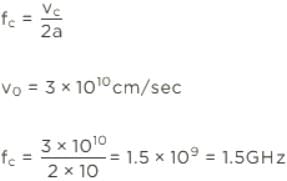Test: Transmission Lines- 2 - Electronics and Communication Engineering (ECE) MCQ
20 Questions MCQ Test - Test: Transmission Lines- 2
If Zsc = 64Ω and Zoc = 100 Ω, the characteristic impedance will be given by.
Consider a lossless line with characteristic impedance R0 and VSWR = S. Then, the impedance at the point of voltage maxima and voltage minima are respectively given by
If K is the reflection coefficient and S is the voltage standing wave ratio, then
In terms of R, L, G and C the propagation constant of a transmission line is given by
A line has Z0 = 300∠0º Ω, and ZL = 150∠0º Ω Voltage standing wave ratio (S) is given by
The characteristic impedance of a distortionless line is
A transmission line with a characteristic impedance Z0 is connected to a transmission line with characteristic impedance Zc. if the systme is being driven by a generator connected to the first line, then the overall transmission coefficient of current will be
Which of the following statements related to a transmission line is/are correct?
1. Transmission line elements are integral parts of the antenna, in some antenna system.
2. A feeder is a particular case of a transmission Sine.
3. A lossless transmission line doesn’t has resistance but, has a non-zero value of leakage conductance.
4. At radio frequency (RF), R and G both are neglected.
Assertion (A): A finite transmission line terminated in its characteristic impedance Z0, is equivalent to an infinite line.
Reason (R): The input impedance of an infinite line is the characteristic impedance of the line.
Consider the following statements:
1. Propagation constant is a dimensionless quantity.
2. When the line is lossless, propagation constant is directly proportional to the frequency.
3. Propagation constant when multiplied with the frequency gives the electrical length of the line.
Which of the above statements is/are true?
Assertion (A): The group velocity is usually more than the phase velocity.
Reason (R): If the transmission line or transmission medium is such that different frequencies travel with different velocities, then the line or the medium is said to be dispersive.
Assertion (A): A transmission line act as resonant circuit and is used in many applications at high frequencies in antenna design and other ratio circuitory
Reason (R): An open and short-circuited lines behaves like resonant circuit when length of line is an integral multiple of λ/3.
Assertion (A): Sometimes a quarter wave line is called as impedance inverter.
Reason (R): The quarter wavelength line transforms a load impedance ZR that is smaller than Z0 into a value Zs that is larger than Z0 and vice-versa.
ln an impedance smith chart, a clockwise movement along a constant resistance circle gives rise to
A transmission line whose characteristic impedance is purely resistive
The input impedance of a short circuited quarter wave long transmission line is
A rectangular air filled waveguide has cross section of 4 cm x 10 cm. The minimum frequency which can propagate in the waveguide is
A 2 kVA transformer has an iron loss of 150 W and a full-loss copper loss of 250 W. At what total loss would the transformer's maximum efficiency occur?









































